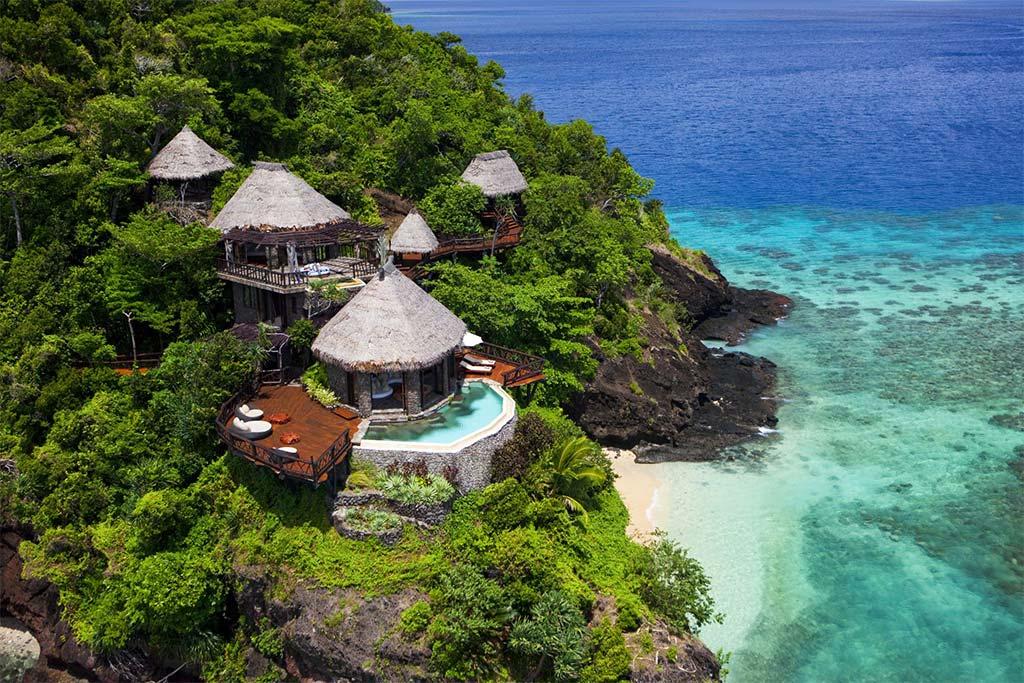Fiji is the most touristic of all the touristic states of Oceania.
More than 300 islands, only a third of which are inhabited, evergreen forests, blue lagoons and beautiful beaches – if you close your eyes and imagine paradise, then probably many will imagine a place like the Republic of Fiji. Fans of swimming and spearfishing, surfers and kiters go here.
Climate
The Fijian climate is tropical, humid and hot. Summer lasts from November to May, the average air temperature at this time is 26 °C. In the summer months, the largest amount of precipitation falls. Winter (from June to the end of October) is drier and cooler, with an average temperature of 23 °C. Hurricanes also occur from November to March. The average air and water temperature in January is 27/28 °C, in July 23/26 °C.
In Fiji, there are no long distances on land, so there is no problem with public transport. Rather, it is practically not developed. On large islands, it is best to take a taxi, and to move between islands by watercraft. Try to avoid hitchhiking and “savages” on the water – it is better to book transport at the hotel. If you return home in the evening after the bar, it is better to take a taxi, which is always on duty near places where tourists gather.

Kitchen
On the islands you will definitely find something to please your stomach. The main choice will be between dishes of local cuisine and culinary traditions of the diaspora living here – Chinese, Korean, Indian and Japanese.
We suggest focusing your attention on local dishes, giving preference to the native flavor, which is based on three whales – seafood (whales are a figurative expression, khe-khe), local root vegetables – primarily taro, and coconuts.
The main dishes of Fijian cuisine are “kakoda” – marinated fish stewed in coconut milk; common dish “slovo” – a large plate with meat, fish, local vegetables and various types of sauces. It is worth paying attention to “palusame” – colocasia leaves cooked in coconut milk. In addition, dozens of types of fish, squid and other sea reptiles are cooked here on coal.
As in Hawaii, earth oven dishes are common. In Chinese communities, the main product is rice and all kinds of dishes made from it. Popular dishes of Fijian Indians, primarily curry, have become familiar to local residents.
Among the drinks, you can single out the “Yangon” drink, sometimes called coffee. It is a non-alcoholic (formally) drink prepared from the roots of a local plant. It contains a large amount of natural narcotic substances, so it causes a state close to alcohol intoxication. Be careful! Even on the islands, they brew a beer that you must try at least for a tick – Fiji Bitter.
Viti Levu Island

Translated as “big island”, it attracts tourists from all over the world. Here is the capital of the island – Suva, international airports and large centers of attraction for a large number of people – night clubs, restaurants. It should be borne in mind that the weather in different parts of the island is very different.
We recommend going to the part called the Hot West – here the sun almost always shines and there is much less precipitation. It is here that the main resorts based around the Pacific Harbor Bay are concentrated. In the capital, you can see the Fiji Museum (fijimuseum.org.fj), which is located in the very center of the city near the government building and the old parliament. Also, pay close attention to the Church of St. Francis Xavier High.
Nausori
Mountainous terrain on the island of Vytu Lviv.
This area is a land of wonderful landscapes and beautiful views. Here, in the land of green jungles and fast rivers, live the most remarkable clans in Fiji. The village of Navala is considered the most picturesque – houses here continue to be built according to the traditions of Polynesian tribes, ignoring the influence of the outside world.
Even with tourists here, the chief of the tribe communicates exclusively, who personally shows the most interesting places. A little further west lies another traditional village – Bukuya, which is also of interest to inquisitive tourists. In the foothills of Nausori there is an interesting botanical park, which has the poetic name “Garden of the Sleeping Giant”.
